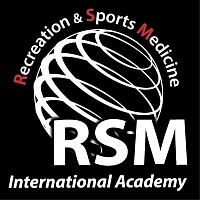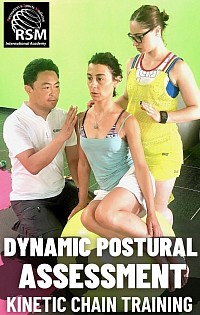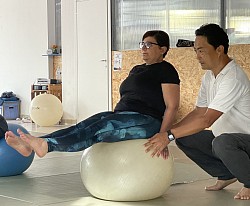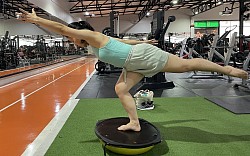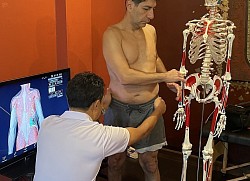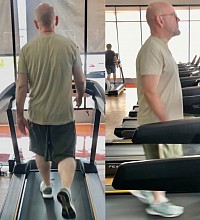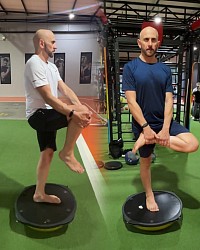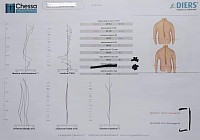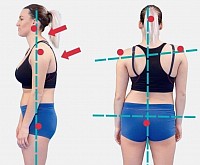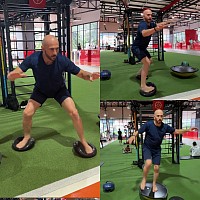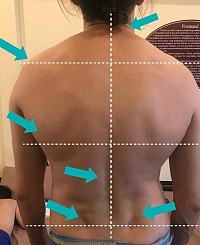Dynamic Postural Assessment & Kinetic Chain Training
Dynamic Postural Assessment for Functional Alignment and Pain Management in Sports Medicine
Dynamic posture assessment enables students to identify compensatory movement patterns, imbalances in the muscles and fascia (neuromyofascial distortions), joint alignment faults, and root causes of pain through functional kinetic chain analysis.
🔸 Based on these sports medicine findings, students will determine whether trigger point therapy, deep tissue massage, or dynamic myofascial release—alone or combined with corrective training—provides the most effective therapeutic solution.
Course Fee & Schedule
🔸 Course Fee - THB 7,000
(approx. EUR 170 / USD 201)
• 2 Days Intensive Course
• The course starts on Saturday at 10:00
• Duration: 8 hours
• Includes Sports Gym Entrance Fee
(Includes postural assessment & video shooting)
🔸 Dynamic postural assessment lesson
10:00-12:00 / 13:00-15:00 from Sat to Sun
🔸 This course refines your clinical application of RSM’s three core methods—Trigger Point Therapy, Deep Tissue Massage, and Dynamic Myofascial Release—focusing on posture correction and pain relief.
You’ll learn to adapt techniques based on functional assessments and client-specific needs
Personalized Postural Optimization - Learn Directly from our Founder's 25 Years of Hands-On Sports Medicine Mastery
This dynamic postural assessment & kinetic chain training program offers direct access to a world-class method developed by Hironori Ikeda, with over 25 years of experience in clinical sports medicine. Each participant receives a personalized biomechanical analysis with visual feedback, identifying postural misalignments and habitual motion errors.
🔸Postural correction training is fully tailored to your postural level, lifestyle, and professional goals—whether for recovery or elite performance. This is a rare chance to learn directly from the founder and master the practical techniques that will transform both your own movement and how you support future clients.
Balance Ball Yoga™ is a World-First Neuromuscular Training Method Built on Core Kinetic Chain Dynamics
Developed by Hironori Ikeda during 25 years of sports medicine massage and performance training, it stems from his master’s research at the University of Tsukuba, Japan. This prestigious institution is renowned for producing 4 Nobel Prize laureates and over 100 Olympic medalists. Hironori's deep understanding of biomechanics and elite athletic performance led to the creation of this globally recognized postural correction method.
🔸 Unstable surface training activates the core kinetic chain, enabling rapid improvements in dynamic postural stability. Applied in top-tier sports and rehabilitation, this method offers faster, more precise outcomes than conventional approaches.
From Static Observation to Dynamic Posture Assessment
Static postural assessment allows physiotherapists, sports trainers, yoga and Pilates instructors, and massage therapists to observe spinal alignment, joint positioning, and muscular tension. However, it cannot fully detect deeper dysfunctions such as limited joint mobility, compensatory postures due to pain, or kinetic chain issues like asymmetrical loading.
🔸 By analyzing real-time motion, students can identify muscular imbalances, limited range of motion, and dysfunctional patterns that static assessments often miss. This is why RSM prioritizes dynamic postural assessment as a core method of evaluation and correction.
Dynamic Postural Assessment for Kinetic Chain Dysfunction and Pain Relief
This advanced module focuses on Dynamic Postural Assessment, allowing participants to detect kinetic chain dysfunctions often overlooked in static evaluations. Using BOSU balls, balance discs, and unstable platforms, postural stability and compensatory movement patterns are assessed in real-time, with emphasis on pain-avoidance behaviors and movement asymmetries.
🔸Participants learn how to address common dysfunctions such as Upper and Lower Crossed Syndromes, myofascial restrictions, neuromuscular imbalances, and post-surgical compensations. Training is customized to fitness level and condition, integrating manual therapy, stretching, and targeted pain relief strategies grounded in biomechanics and functional anatomy.
Build Your Ability to Create Optimized Massage Protocols Through Dynamic Postural Assessment
Dynamic Postural Assessment, rooted in sports medicine and biomechanics, equips therapists to identify antalgic posture, pain-avoidance behavior, and key dysfunctions such as Upper and Lower Crossed Syndromes. It prioritizes dynamic motion analysis over static alignment, allowing for more accurate observation of kinetic chain imbalances and compensatory movement patterns.
🔸 This Training Course, developed over 25 years of clinical experience, is designed for practitioners in sports massage, bodywork, and manual therapy who seek a biomechanics-based approach to posture correction and movement optimization. It is ideal for those looking to deepen their skills through real-world, experience-driven learning.
The training focuses on four core techniques essential for structural assessment and therapeutic application:
🔸 Trigger Point Therapy for pain relief and compensatory movement correction
🔸 Deep Tissue Massage for restoring joint mobility and fascial release
🔸 Dynamic Myofascial Release for addressing nerve glide and myofascial tension
🔸 Breathing and Spine Mobility for postural control through spinal mechanics and breathwork
Become Your Own Case Study: An Expert Review of Your Movement
This course is tailored for those who have completed Trigger Point Therapy and seek to integrate palpation skills into dynamic movement analysis. Through personal case studies and structured video assessments, participants investigate their own postural misalignments and kinetic movement imbalances. This hands-on exploration bridges theory with real-time biomechanical insight.
🔸 Under direct supervision by Hironori Ikeda, each student’s movement is reviewed in detail, revealing inefficiencies in kinetic chains and highlighting areas for structural refinement. These insights directly enhance application in upcoming Deep Tissue Massage Course, Orthopedic Massage Course for Breathing & Spine Mobility, and Dynamic Myofascial Release course -making each technique clinically precise and context-specific.
